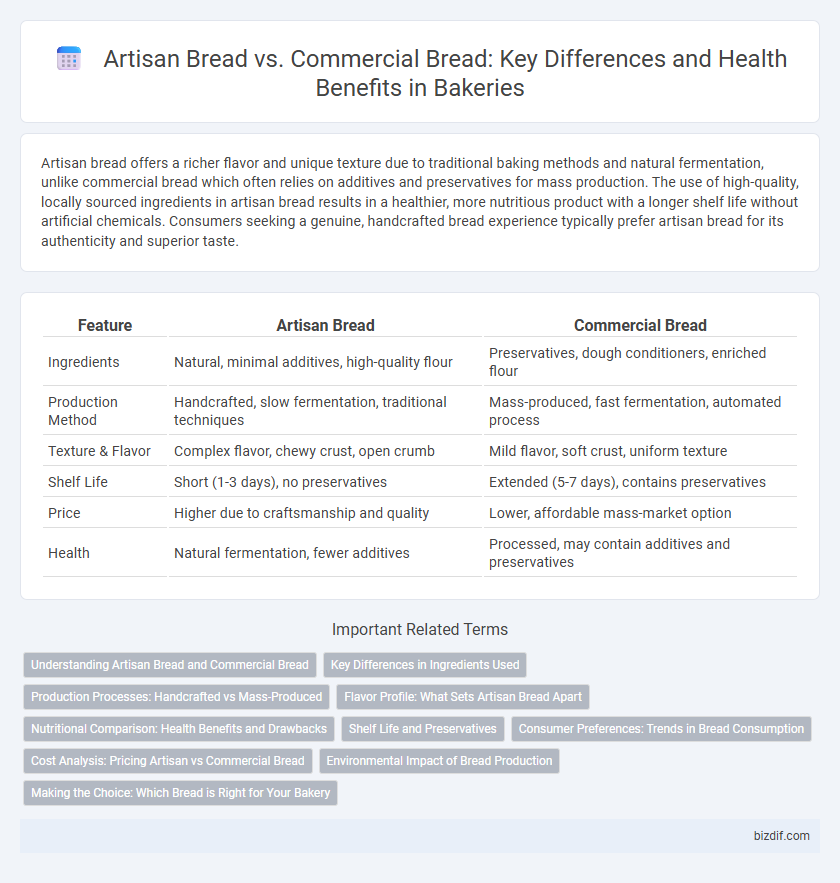Artisan bread offers a richer flavor and unique texture due to traditional baking methods and natural fermentation, unlike commercial bread which often relies on additives and preservatives for mass production. The use of high-quality, locally sourced ingredients in artisan bread results in a healthier, more nutritious product with a longer shelf life without artificial chemicals. Consumers seeking a genuine, handcrafted bread experience typically prefer artisan bread for its authenticity and superior taste.
Table of Comparison
| Feature | Artisan Bread | Commercial Bread |
|---|---|---|
| Ingredients | Natural, minimal additives, high-quality flour | Preservatives, dough conditioners, enriched flour |
| Production Method | Handcrafted, slow fermentation, traditional techniques | Mass-produced, fast fermentation, automated process |
| Texture & Flavor | Complex flavor, chewy crust, open crumb | Mild flavor, soft crust, uniform texture |
| Shelf Life | Short (1-3 days), no preservatives | Extended (5-7 days), contains preservatives |
| Price | Higher due to craftsmanship and quality | Lower, affordable mass-market option |
| Health | Natural fermentation, fewer additives | Processed, may contain additives and preservatives |
Understanding Artisan Bread and Commercial Bread
Artisan bread is crafted using traditional methods with high-quality, natural ingredients, resulting in a dense crumb and complex flavors enhanced by long fermentation. Commercial bread relies on industrial processes, additives, and preservatives to ensure uniform texture, extended shelf life, and mass production efficiency. Understanding these differences highlights the emphasis on quality and craftsmanship in artisan bread versus the convenience and scalability of commercial bread.
Key Differences in Ingredients Used
Artisan bread uses simple, natural ingredients such as flour, water, salt, and wild yeast or sourdough starters, resulting in complex flavors and a chewy texture. Commercial bread often contains additives like preservatives, dough conditioners, and high-fructose corn syrup to enhance shelf life and uniformity. The absence of artificial ingredients in artisan bread promotes better digestibility and a more authentic taste profile compared to mass-produced commercial loaves.
Production Processes: Handcrafted vs Mass-Produced
Artisan bread is crafted through traditional, hands-on methods involving slow fermentation, natural ingredients, and skilled techniques that enhance flavor and texture. Commercial bread relies on mechanized, mass-production processes using additives and rapid rising agents to achieve uniformity and higher volume at lower costs. The handcrafted approach results in unique, high-quality loaves with complex flavors, whereas mass-produced bread prioritizes consistency and efficient scalability.
Flavor Profile: What Sets Artisan Bread Apart
Artisan bread features complex, rich flavor profiles derived from long fermentation processes and natural sourdough starters, which develop deeper acidity and nuanced notes. Commercial bread typically uses faster, industrialized methods with added enzymes and preservatives, resulting in a milder, more uniform taste. These distinct production techniques highlight the superior taste complexity that defines artisan bread.
Nutritional Comparison: Health Benefits and Drawbacks
Artisan bread typically offers higher nutritional value due to its natural fermentation process, which enhances digestibility and increases the bioavailability of nutrients like vitamins and minerals. In contrast, commercial bread often contains preservatives, added sugars, and refined flours, resulting in lower fiber content and potential blood sugar spikes. While artisan bread supports gut health with beneficial probiotics, commercial bread's additives may contribute to inflammation and reduced nutrient absorption.
Shelf Life and Preservatives
Artisan bread typically has a shorter shelf life due to its lack of preservatives and reliance on natural fermentation processes. Commercial bread often contains additives and preservatives like calcium propionate to extend freshness and prevent mold growth. The absence of chemical preservatives in artisan bread results in a more natural flavor but necessitates faster consumption.
Consumer Preferences: Trends in Bread Consumption
Consumers increasingly favor artisan bread due to its natural ingredients, unique flavors, and traditional baking methods, aligning with a growing demand for health-conscious and authentic food products. Commercial bread remains popular for its consistent quality, affordability, and convenience, catering to busy lifestyles and budget-conscious shoppers. Market trends indicate a rising preference for whole grain and sourdough varieties, reflecting broader wellness and sustainability concerns in bread consumption.
Cost Analysis: Pricing Artisan vs Commercial Bread
Artisan bread typically commands higher prices due to handcrafted techniques, premium ingredients, and longer fermentation times, resulting in greater production costs compared to commercial bread. Commercial bread benefits from mass production efficiencies, lower-cost ingredients, and faster baking processes, which reduce overall expenses and retail prices. Consumers often accept the price premium for artisan bread because of superior flavor, texture, and perceived quality, influencing bakery pricing strategies and market positioning.
Environmental Impact of Bread Production
Artisan bread production typically uses traditional methods with minimal processing, resulting in a lower carbon footprint compared to commercial bread, which often relies on industrialized, energy-intensive processes. The use of locally sourced ingredients in artisan bread reduces transportation emissions, whereas commercial bread production involves large-scale distribution networks that contribute significantly to greenhouse gas emissions. Waste generation and packaging in commercial bread further increase its environmental impact compared to the more sustainable practices observed in artisan bakeries.
Making the Choice: Which Bread is Right for Your Bakery
Artisan bread is crafted using traditional methods, long fermentation, and natural ingredients, resulting in complex flavors and a rustic texture that appeals to discerning customers. Commercial bread relies on faster processes, additives, and preservatives, ensuring uniformity, extended shelf life, and cost efficiency ideal for high-volume production. Bakers must weigh factors like target market preferences, bakery size, and production capacity to decide between the authenticity of artisan bread and the scalability of commercial bread.
Artisan Bread vs Commercial Bread Infographic

 bizdif.com
bizdif.com